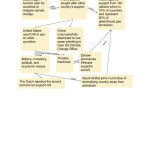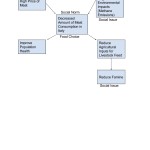I will be assessing my hometown for natural hazard events. My hometown is Peters Township Pennsylvania, which is a suburb approximately forty minutes south of Pittsburgh. Using the Nathan World Map of Natural Hazards, I determined that my hometown is at risk for tornadoes and extratropical storms or winter storms. Peters Township is at low risk for earthquakes and wildfires. According to the map, Peters Township is somewhere between zone 2 and zone 3 for tornado risk. Peters Township is in the zone 3 for the extratropical storms. These maps are a good source for determining general areas where different natural hazards are common. However, the maps make it difficult to determine the exact boarders and locations of various areas.
Using the Hungarian National Association of Radio Distress Signaling and Infocommunications’ (RSOE) Emergency and Disaster Information Service (EDIS), I discovered an Environmental Pollution incident in the state of Louisiana. Specifically, the incident occurred in the Bayou Teche waterway near Morgan City. The incident occurred on March 29th at approximately eight in the morning. The threat level is reported as “medium.” The website does not reveal details about the type of environmental pollution, but my hometown is at risk for environmental pollution events. My hometown is in an industrial area that also has farming as well as hydraulic fracturing infrastructure. All of these systems can result in environmental pollution. However, the incident in Louisiana resulted in contamination of a major waterway where as my hometown does not have a major waterway. Morgan City is a smaller scale than Peters Township. Peters Township has approximately twice the population of Morgan City. If an environmental incident occurred in Peters Township the contamination may be more contained than in the Bayou Teche waterway. The contamination in the Bayou Teche waterway will likely spread the contamination to a larger scale and have a larger impact on the environment. Often times with environmental contamination, children and pregnant women are the most vulnerable to the pollutants. Insuring that schools and homes are free of contamination is absolutely vital to protect these vulnerable populations.
According to USA.com, tornadoes are the main natural hazard threat in western Pennsylvania1. Western Pennsylvania also has a large record of floods and hail1. From my personal experience, I have seen flooding, hail storms, and a microburst in Peters Township. I live on a protected wetland and throughout the past 15 years, the creek that runs through my front yard has flooded on multiple accounts. I also witnessed a microburst in which over fifty trees in my yard were uprooted and broken. My personal experience is in agreement with USA.com and the Nathan World map, in that Peters Township in susceptible to tornadoes, winter storms, as well as some flooding and hailstorms.
In order to reduce the vulnerability to tornadoes and winter storms in Peters Township, households should maintain supplies in case of an incident. All households should have food and water in case of a natural hazard event. Households should also have a plan in place in the event of a tornado. Specifically, children should be taught to go to a secure room without windows, typically a basement or bathroom. Schools should also implement tornado drills in which the students go to a designated area away from windows. The students should also be taught how to protect their head while in the designated area incase of flying debris. Parents and teachers should implement these emergency plans to decrease vulnerability. I can make sure to follow my own advice and keep emergency supplies stocked and implement an emergency plan in the event of a natural hazard event.
- “Pittsburgh, PA Natural Disasters and Weather Extremes,” USA.com, 29March2016, http://www.usa.com/pittsburgh-pa-natural-disasters- extremes.htm.



